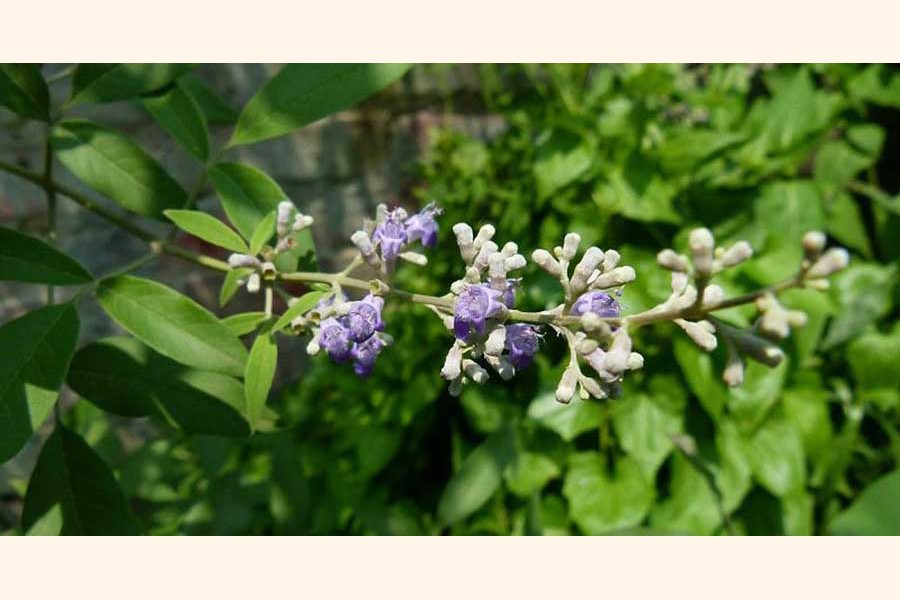Nishinda plant or Vitex Negundo has been widely used in herbal medicine for around five to seven thousand years. Up until now, its beneficial effects have been recognised in possessing anti-inflammatory, anti-rheumatic, antipyretic, hepato-protective and antioxidant properties. With the surging panic spread everywhere around the globe about Covid-19, there has been an interesting development about Nishinda in Bangladesh. Suddenly everyone was in need of the plant and it became out of market.
The novel Corona virus 2019 or Covid-19 took the world by storm when it first emerged in Wuhan city of China last December. It has till now infected more than half a million people with death toll nearing 30 thousands. No cure for this pandemic has yet been developed. So, only weapon to fight it is social distancing and sanitisation.
The sudden demand for Nishinda plant in our country appeared after a seminar held by a group of scientists from the University of Development Alternative (UODA). For research on virus, ultra-modern Biosafety Level 3 laboratory is needed which is only available in ICDDRB (International Centre for Diarrhoeal Disease Research, Bangladesh) in our country. Despite the constraints of not having adequate laboratory facilities, a team of 14 members from UODA lead by Professor Mohammed Rahmatullah, Dean of Life Science faculty and his wife Professor Rownak Jahan, Chairperson of Biotechnology department, began their journey to find out effective compounds which could be useful in developing a cure for COVID- 19. They started their research by dry testing in computer simulation with a process called molecular docking. This programme is designed to see whether a large protein molecule can bind to a smaller structure, and if it can, how strong the bond would be along with a 3D structure presentation.
The team opted to figure out a protein structure of the novel Corona virus that could be sequenced using molecular docking in order to get a 3D picture. With much success, they were able to sequence C3 protease protein of the virus that has 80 per cent similarity with the previous SARS virus. The target was to find a chemical compound that could bind to the protein component of the virus and deactivate it.
Focus was on plant derived chemicals since plants are the oldest and most widely used source of medicinal drugs. First choice was Neem plant for its known beneficial effects. Second choice was Drumstick tree, commonly known as 'Shojina' tree in Bangladesh, which also failed to show any promising result. On the third choice of plants, they picked up the plant called Nishinda.
"Five components of Nishinda namely Apigenin, Vitexin, Isovitexin, Negundinand Castaicin have shown affinity for active site of the viral protein," said Professor Rahmatullah. Similar results were gained using both optimised and non-optimised structures. These results were sent to Dr. Taufiq Rahman at Cambridge University who ran the programme using more advanced Auto Dock 4.2 technology and found positive results again. The data was further rechecked by Professor Jerry Rick from Kansas State University, USA. With the affirmative outcomes these scientists have achieved until now, they are looking forward to publishing an international paper about their research. As soon as the paper gets published, the formula can go into wet testing which has shown immense possibility in developing a drug for coronavirus.
After the seminar that revealed the possibility of a plausible cure from Nishinda, the plants were out of market in a couple of days in Bangladesh. Professor Rahmatullah's response to this misconception of eating Nishinda plant was clear however. "Nishinda contains thousands of chemical components among which some might be harmful. So, do not eat Nishinda plant," he said. In fact, the veteran advocated eating Black Cumin or Kalijira as it also contains Apigenin, which could potentially be effective against the virus. So, in case anyone is wondering whether eating the leaves of Nishinda might be helpful, they are strongly discouraged to do so.
The motivation of the team behind working in this project is truly commendable. When asked what inspired the duo to work in this project, Professor Rownak replied that they had been carrying out researches and surveys about herbs in medicine for many years now. They even have data of different herbal medicines used by 70 aboriginal ethnicities of Bangladesh. In case a drug is developed based on the research first carried out by them, they have no intention of patenting it, since they want it to be available to a larger population at a lower cost.
It is the challenge of the century to develop a cure for coronavirus. With numerous researches going around all over the world, it is quite remarkable how far these Bangladeshi scientists have come. If this initiative can lead to the development of a drug, it will be a matter of immense pride and glory for Bangladesh as well as a bold step for the cause of humanity.
Sabeeh Sabrat Oyshi is an MBBS student at Dhaka Medical College.


